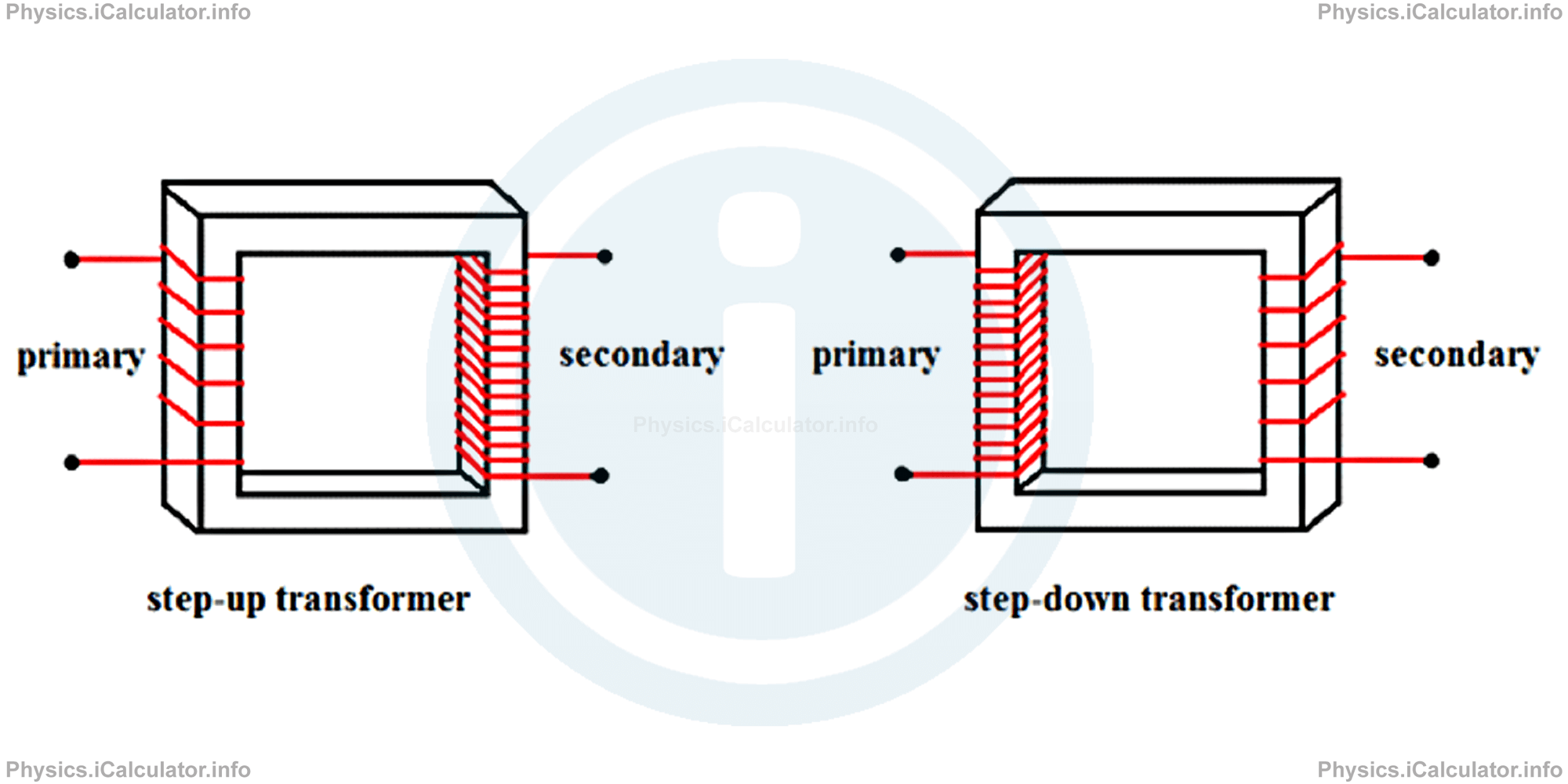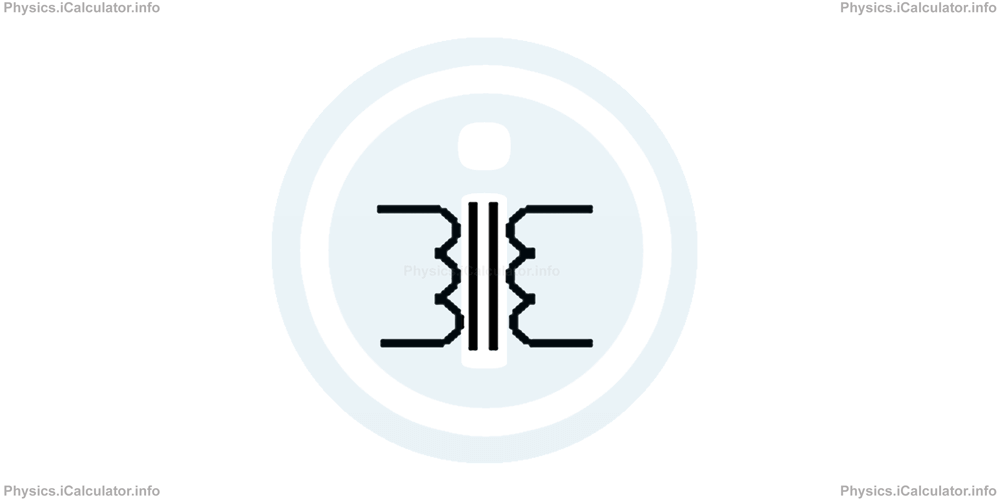Menu
Physics Lesson 16.17.3 - How does a Transformer Work?
Please provide a rating, it takes seconds and helps us to keep this resource free for all to use
Welcome to our Physics lesson on How does a Transformer Work?, this is the third lesson of our suite of physics lessons covering the topic of Power in an Alternating Circuit. Transformers, you can find links to the other lessons within this tutorial and access additional physics learning resources below this lesson.
How does a Transformer Work?
An ideal transformer contains a rectangular core (empty at middle) with two coils wound around the opposing arms. The core is made of insulating material to prevent the flow of undesired currents (Foucault currents). The coil connected with the input is called the primary coil while the one connected with the output is called secondary coil.

As seen from the figures, step-up transformers have more turn in the secondary coil while step-down transformers have more turns in the primary coil. The alternating current flowing through the primary coil produces a variable magnetic flux in the core. Since the number of turns is different, the flux produced in the secondary coil changes, generating an induced emf in the secondary coil (in the primary coil the emf is due to the input source). However, the frequency of current (and voltage) doesn't change. This is an indicator of the relationship between currents and voltages in each coil of transformer.
The symbol of transformers in electric circuits is 
An ideal transformer has no any power loss during the induction from primary to secondary coil. However, this is not possible. Some of the energy (power) is lost during this process despite the coils are made of soft iron to reduce this loss. Hence, we can write
where 1 stands for input (primary coil) and 2 for output (secondary coil). The equality sign stands for ideal transformers. Thus, we obtain for the efficiency of transformer:
Obviously, an ideal transformer is 100% efficient as no energy is lost during the induction.
We will explain the rest of transformers theory considering only ideal transformers. Thus, based on the power formula shown above, the relationship between currents and voltages in an ideal transformer is
The relationship between the emf's and the number of turns in each coil is
where N1 and N2 are the numbers of turns in the primary and secondary coil respectively. The ratio N1/N2 is called the turns factor.
For ideal transformers, the emf's in each coil are equal to the corresponding voltages at their ends. Hence, we can write
Combining all the above equations, we obtain for an ideal transformer
This means the current is inversely proportional to electromotive force, voltage and number of turns in the transformer.
The equation
is known as the equation of transformer.
Example 2
The voltage in the primary coil of a transformer is 220 V and the number of turns in this coil is 1000. If the number of turns in the secondary coil is 50, find:
- What type of transformer is this?
- The voltage in the secondary coil is the transformer is ideal
- The voltage in the secondary coil if the transformer is 80% efficient
- The current in the secondary coil for both situations above if the input current is 4.4 A.
Solution 2
- This is a step-down transformer as the number of turns in the secondary coil is smaller than in the primary coil (N1 = 1000, N2 = 50).
- If the transformer is ideal, we have ∆V2/∆V1 = N2/N1Substituting the known values, we obtain∆V2/220 V = 50/1000Thus,∆V2 = 50 ∙ 220 V/1000
= 11 V - If the transformer is 80% efficient, we obtain for the output voltage ∆V1 = 80% ∙ ∆V2(ideal) = 0.80 ∙ 11V = 8.8 V
- For ideal transformer we have i1 ∙ ∆V1 = i2 ∙ ∆V2Since i1 = 4.4 A, we have(4.4 A) ∙ (220 V) = i2 ∙ (11 V)Since we have considered the efficiency when finding the output voltage, it is obvious that the current remains the same even in the real transformer. Hence, we have
i2 = (4.4 A) ∙ (220 V)/(11 V)
= 88 Ai2 = 88 A
You have reached the end of Physics lesson 16.17.3 How does a Transformer Work?. There are 3 lessons in this physics tutorial covering Power in an Alternating Circuit. Transformers, you can access all the lessons from this tutorial below.
More Power in an Alternating Circuit. Transformers Lessons and Learning Resources
Whats next?
Enjoy the "How does a Transformer Work?" physics lesson? People who liked the "Power in an Alternating Circuit. Transformers lesson found the following resources useful:
- Functionality Feedback. Helps other - Leave a rating for this functionality (see below)
- Magnetism Physics tutorial: Power in an Alternating Circuit. Transformers. Read the Power in an Alternating Circuit. Transformers physics tutorial and build your physics knowledge of Magnetism
- Magnetism Revision Notes: Power in an Alternating Circuit. Transformers. Print the notes so you can revise the key points covered in the physics tutorial for Power in an Alternating Circuit. Transformers
- Magnetism Practice Questions: Power in an Alternating Circuit. Transformers. Test and improve your knowledge of Power in an Alternating Circuit. Transformers with example questins and answers
- Check your calculations for Magnetism questions with our excellent Magnetism calculators which contain full equations and calculations clearly displayed line by line. See the Magnetism Calculators by iCalculator™ below.
- Continuing learning magnetism - read our next physics tutorial: Maxwell Equations
Help others Learning Physics just like you
Please provide a rating, it takes seconds and helps us to keep this resource free for all to use
We hope you found this Physics lesson "Power in an Alternating Circuit. Transformers" useful. If you did it would be great if you could spare the time to rate this physics lesson (simply click on the number of stars that match your assessment of this physics learning aide) and/or share on social media, this helps us identify popular tutorials and calculators and expand our free learning resources to support our users around the world have free access to expand their knowledge of physics and other disciplines.
Magnetism Calculators by iCalculator™
- Angular Frequency Of Oscillations In Rlc Circuit Calculator
- Calculating Magnetic Field Using The Amperes Law
- Capacitive Reactance Calculator
- Current In A Rl Circuit Calculator
- Displacement Current Calculator
- Electric Charge Stored In The Capacitor Of A Rlc Circuit In Damped Oscillations Calculator
- Electric Power In A Ac Circuit Calculator
- Energy Decay As A Function Of Time In Damped Oscillations Calculator
- Energy Density Of Magnetic Field Calculator
- Energy In A Lc Circuit Calculator
- Faradays Law Calculator
- Frequency Of Oscillations In A Lc Circuit Calculator
- Impedance Calculator
- Induced Emf As A Motional Emf Calculator
- Inductive Reactance Calculator
- Lorentz Force Calculator
- Magnetic Dipole Moment Calculator
- Magnetic Field At Centre Of A Current Carrying Loop Calculator
- Magnetic Field In Terms Of Electric Field Change Calculator
- Magnetic Field Inside A Long Stretched Current Carrying Wire Calculator
- Magnetic Field Inside A Solenoid Calculator
- Magnetic Field Inside A Toroid Calculator
- Magnetic Field Produced Around A Long Current Carrying Wire
- Magnetic Flux Calculator
- Magnetic Force Acting On A Moving Charge Inside A Uniform Magnetic Field Calculator
- Magnetic Force Between Two Parallel Current Carrying Wires Calculator
- Magnetic Potential Energy Stored In An Inductor Calculator
- Output Current In A Transformer Calculator
- Phase Constant In A Rlc Circuit Calculator
- Power Factor In A Rlc Circuit Calculator
- Power Induced On A Metal Bar Moving Inside A Magnetic Field Due To An Applied Force Calculator
- Radius Of Trajectory And Period Of A Charge Moving Inside A Uniform Magnetic Field Calculator
- Self Induced Emf Calculator
- Self Inductance Calculator
- Torque Produced By A Rectangular Coil Inside A Uniform Magnetic Field Calculator
- Work Done On A Magnetic Dipole Calculator